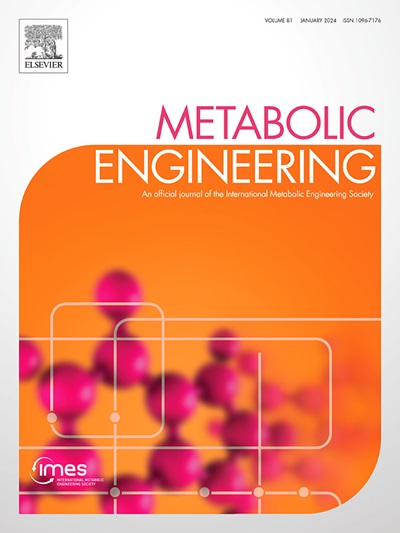对酿酒酵母甾醇合成途径进行系统工程改造,促进了β-石竹烯的高效生产。
IF 6.8
1区 生物学
Q1 BIOTECHNOLOGY & APPLIED MICROBIOLOGY
引用次数: 0
摘要
β-石竹烯是一种植物衍生的倍半萜,可作为食品调味剂、抗炎剂、抗氧化剂和高能燃料来源。从植物中提取β-石竹烯是一种成本高、效率低的工艺。因此,微生物细胞工厂已被用于生产β-石竹烯。然而,有限的产量不足以满足其工业应用。在本研究中,我们通过系统调节甾醇合成途径来平衡细胞对生长和生产资源的利用,从而最大限度地合成β-石竹烯。在甾醇和脂肪酸合成的竞争通路中,通过分别用葡萄糖敏感启动子PHXT1和甾醇合成启动子PERG7取代原始启动子来抑制基因的表达。该方法有效提高了β-石竹烯产量6.8倍,达到854.7 mg/L。工程葡萄糖感应途径改变了PHXT1的强度,导致β-石竹烯产量增加到1.25 g/L。二倍体融合进一步促进了细胞的生长和β-石竹烯的产量,分批补料发酵时β-石竹烯的产量为21.4 g/L。这是迄今为止报道的最高的β-石竹烯产量。本研究为微生物细胞工厂生产倍半萜提供了有价值的参考。本文章由计算机程序翻译,如有差异,请以英文原文为准。

Systematic engineering of the sterol synthesis pathway for Saccharomyces cerevisiae promotes the efficient production of β-caryophyllene
β-caryophyllene, a plant-derived sesquiterpene, serves as a food flavoring, anti-inflammatory agent, antioxidant, and high-energy fuel source. Extraction of β-caryophyllene from plants is a costly and inefficient process. Therefore, microbial cell factories have been employed for the production of β-caryophyllene. However, the limited yield is insufficient for its industrial application. In this study, we balanced the utilization of cellular resources for growth and production by systematically regulating the sterol synthesis pathway to maximize the synthesis of β-caryophyllene. In the competitive pathways concerning sterol and fatty acid synthesis, genes expression was suppressed by substituting the original promoters with a glucose-sensing promoter PHXT1 and a sterol synthesis promoter PERG7, respectively. This approach effectively increased the production of β-caryophyllene by 6.8 times, reaching 854.7 mg/L. Engineering glucose-sensing pathway altered the strength of PHXT1, resulting in an increase in β-caryophyllene production to 1.25 g/L. The cell growth and β-caryophyllene production were further boosted through diploid fusion, resulting in 21.4 g/L β-caryophyllene in fed-batch fermentation. This represents the highest reported production of β-caryophyllene to date. This study provides a valuable reference for the production of sesquiterpenes in microbial cell factories.
求助全文
通过发布文献求助,成功后即可免费获取论文全文。
去求助
来源期刊

Metabolic engineering
工程技术-生物工程与应用微生物
CiteScore
15.60
自引率
6.00%
发文量
140
审稿时长
44 days
期刊介绍:
Metabolic Engineering (MBE) is a journal that focuses on publishing original research papers on the directed modulation of metabolic pathways for metabolite overproduction or the enhancement of cellular properties. It welcomes papers that describe the engineering of native pathways and the synthesis of heterologous pathways to convert microorganisms into microbial cell factories. The journal covers experimental, computational, and modeling approaches for understanding metabolic pathways and manipulating them through genetic, media, or environmental means. Effective exploration of metabolic pathways necessitates the use of molecular biology and biochemistry methods, as well as engineering techniques for modeling and data analysis. MBE serves as a platform for interdisciplinary research in fields such as biochemistry, molecular biology, applied microbiology, cellular physiology, cellular nutrition in health and disease, and biochemical engineering. The journal publishes various types of papers, including original research papers and review papers. It is indexed and abstracted in databases such as Scopus, Embase, EMBiology, Current Contents - Life Sciences and Clinical Medicine, Science Citation Index, PubMed/Medline, CAS and Biotechnology Citation Index.
 求助内容:
求助内容: 应助结果提醒方式:
应助结果提醒方式:


